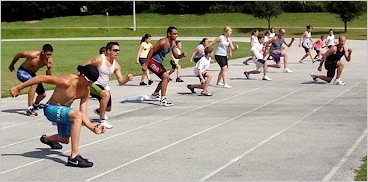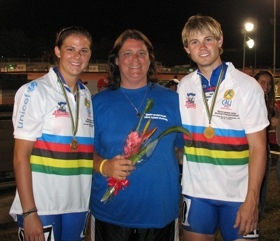 | ||
| ||||||||
By Renee Hildebrand
Team Florida practices an off-skate drill. It's hard to say exactly when one skating season ends and the next begins. Seasons vary from country to country, from indoors to outdoors, and from skater to skater. But regardless of the timing, one thing remains constant: every skater needs to take some time off after a long, hard season to rest and recover. A break of two to four weeks is generally beneficial. However, any longer can be harmful and cause a decline in skill levels and speed. Active Rest If skaters insist on going without a break, it's important that they limit themselves for a time to what I call "active rest" workouts. During these "preseason" sessions, training should focus on technique, flexibility, balance and skating skills — not on speed or power. For my team, this phase of training starts in August or September. Phase One My team starts what I call "phase one" of training in October. In this phase, I gradually put more emphasis on power, strength and endurance. This is the most important part of training; it lays a foundation for the rest of the year. Proper preseason and phase one training helps prevent over-use injuries, such as muscle strains, later in the season. During these phases, we do lots of technique drills and emphasize proper form and power. Drills and off-skate exercises are performed slowly and deliberately. I even ask the skaters to exaggerate the motions, and I give constant feedback to ensure correct execution of each drill. By exaggerating, or overcorrecting, you train your muscles to do the motion correctly — without even thinking about it! But just remember: it takes at least 600 repetitions for this to work. (Think of it as "over-correction to perfection.") Most technique drills and off-skate exercises are performed in the skating position, in other words: squatting. This strengthens the leg muscles and improves their ability to tolerate the static contractions necessary to maintain the skating position. Sample Training Program Below is an example of a Phase One training program (Note: each athlete should have their own personal schedule based on age, skill level and goals.) Strengthening and Balance
Power and Technique Exercises These exercises should be done twice a week. Before you start, warm-up for 10 minutes and stretch to avoid muscle strains. Start out with one set of 10 repititions for each exercise, with 30 second rest interval, doing each exercise slowly and with perfect technique. Add another set of 10 when you can complete the first set with good form comfortably. By the fourth week, you should be doing three sets of 10 reps of each exercise.
Endurance and Cardiovascular Conditioning
There are many ways to improve your cardiovascular conditioning, among them running, cycling and using an elliptical trainer. But outdoor skating should be your No. 1 choice: If you are training to skate, skate to train! The important thing to remember is that you must perform your chosen activity continuously for 30 to 60 minutes and that during that time, you must keep your heart rate in your target "heart rate zone." Everyone's target heart range is different, depending on age, conditioning and other factors. Well-conditioned athletes, ages 12-20, usually fall into a range of 145 to 185 beats per minute. (Here's the CDC's guide to determining your target heart rate.) It takes a few minutes to reach your target heart rate, so don't start the clock ticking on your 30-60 minute workout until you're there. Nov. 2, 2007 ...
• Renee's page on the Skater Network
Related reading: • Skate Tip of the Week Archive
...
Copyright © 2007-2009 by Inline Planet | ||||||||

 Renee Hildebrand is one of the most successful coaches in the history of inline speed skating. Among the skaters she has coached are world champions Joey Mantia and Brittany Bowe and Belgian champion Bart Swings. Hildebrand is the head coach of Team Florida of Skateworld in Tampa, Florida.
Renee Hildebrand is one of the most successful coaches in the history of inline speed skating. Among the skaters she has coached are world champions Joey Mantia and Brittany Bowe and Belgian champion Bart Swings. Hildebrand is the head coach of Team Florida of Skateworld in Tampa, Florida.